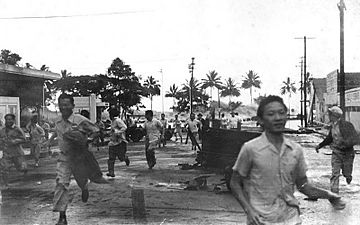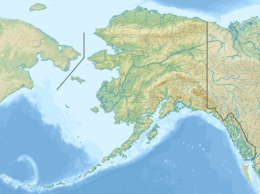1946 Aleutian Islands earthquake facts for kids

Fleeing an approaching tsunami in Hilo, Hawai'i
|
|
| UTC time | 1946-04-01 12:29:01 |
|---|---|
| ISC event | 898313 |
| USGS-ANSS | ComCat |
| Local date | 1 April 1946 |
| Local time | 03:29 |
| Magnitude | 8.6 Mw |
| Depth | 15 km (9.3 mi) |
| Epicenter | 53°29′N 162°50′W / 53.49°N 162.83°W |
| Areas affected | Hawaii, Alaska United States |
| Max. intensity | VI (Strong) |
| Tsunami | Yes |
| Casualties | 165–173 |
The 1946 Aleutian Islands earthquake happened near the Aleutian Islands in Alaska on April 1, 1946. It was a very strong earthquake, measuring 8.6 on the Moment magnitude scale. The shaking was felt as "Strong" in some areas.
This earthquake caused a huge tsunami that affected many places across the Pacific Ocean. Between 165 and 173 people lost their lives, and there was over $26 million in damage.
What Happened?
The earthquake made the seafloor move upwards. This sudden movement created a giant tsunami. The tsunami sent several powerful waves across the Pacific. Some waves were as tall as 45 to 130 feet (about 14 to 40 meters).
One of the first places hit was the Scotch Cap Lighthouse on Unimak Island, Alaska. The tsunami completely destroyed the lighthouse. All five lighthouse keepers there died. Even with this destruction, the tsunami did not cause much damage on the Alaskan mainland.
The Tsunami's Journey
Reports said the tsunami waves traveled across the ocean very fast, at about 500 miles per hour (800 km/h). The waves were about 55 feet (17 meters) high from their lowest point to their highest.
The wave reached Kauai, Hawaii about 4.5 hours after the earthquake. It arrived in Hilo, Hawaii about 4.9 hours later. Hilo was hit very hard. Many people died, and hundreds were injured. Almost 500 buildings were completely destroyed, and nearly 1,000 more were damaged.
Witnesses described how the waves flooded streets, homes, and stores. Many people were swept out to sea when the water pulled back. The tsunami also caused a lot of damage in Maui. There, 77 homes and many other buildings were destroyed.
People in Hawaii were not ready for the tsunami. This was because the warning systems from places like Scotch Cap Lighthouse were destroyed. Because it happened on April 1st, the tsunami is often called the April Fools' Day Tsunami in Hawaii. The tsunami's effects were also felt in Washington, Oregon, and California.
Learning from the Disaster
This tsunami was unusually powerful compared to the size of the earthquake. Scientists call this a "tsunami earthquake." This means the earthquake itself might not feel super strong, but it creates a very big tsunami.
The widespread damage from this event led to an important change. It made people realize the need for a better warning system. This led to the creation of the Seismic Sea Wave Warning System. Later, in 1949, this system became the Pacific Tsunami Warning Center. This center now helps warn people about tsunamis across the Pacific Ocean.
See also



